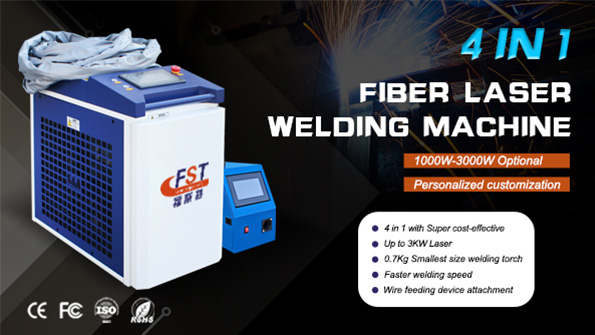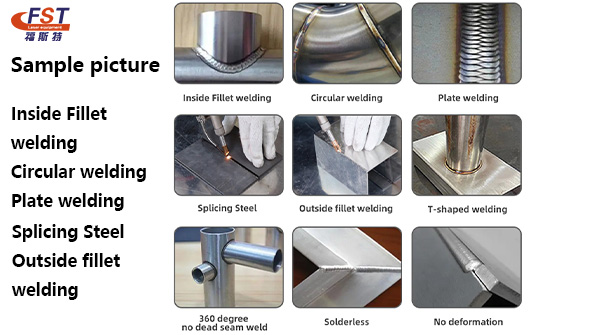In the world of precision welding, the quality of every weld is crucial to the performance and service life of the product. The focus adjustment of the welder machines laser welding is the
key factor that determines the quality of the weld. The accuracy of the focal length directly affects the stability of the welding effect and the quality of the weld. Foster Laser has been deeply
engaged in the field of laser welding for many years. With its pursuit of technical excellence and profound insight into user needs, it has summed up a set of simple and practical “seeing with
eyes + listening with ears” focus-finding tips. In just three steps, you can easily handle laser welding, produce perfect welds, and master the debugging skills of laser welding machines.
Step 1: Check the Red Light to Lay a Solid Foundation for Welding
The red light is like the “eyes” of the laser welding machine, and its state directly affects the accuracy of welding. Before starting to adjust the focal length, we must first ensure that these “eyes”
are clear and bright.
The operation is very simple. First, remove the wire feeding tube, which can provide more space for subsequent operations and facilitate our detailed inspection to ensure unobstructed
observation. Then take off the copper nozzle, and at this time, you can clearly observe whether the red light is normal and whether there are black spots or divergence and blur. If the red light is
skewed or out of focus, it may be due to lens contamination or optical path deviation, which requires further inspection. It should be noted that if there are black spots in the red light, it is like
human eyes being covered with impurities, which will lead to uneven distribution of laser energy and thus affect the welding effect.
Step 2: Replace Lenses to Ensure Stable Energy
In the laser transmission system, the cleanliness and state of the lenses are crucial. They are important “bridges” for energy transmission in laser welding machines, and their state directly
determines the output efficiency and stability of laser energy. Inspect in the following order:
Protective lens: It bears the brunt and is most vulnerable to contamination or ablation.
Focusing lens: It determines the quality of the light spot, so it is necessary to focus on checking whether there are burn marks or abnormal coating.
Reflective mirror & collimating lens: It should be noted that the structure of the reflective lens and collimating lens is relatively complex. Without professional experience, if you need to
disassemble and inspect them, it is recommended to contact Foster’s official technical personnel for assistance. They have rich experience and professional knowledge and can provide you with
accurate guidance to avoid more damage caused by operational errors.
If it is temporarily impossible to determine the problematic lens, you may try to replace the protective lens and focusing lens first. This is because these two types of lenses are more susceptible
to splashes, dust and other factors in daily use, resulting in problems with the lenses themselves or their coatings. The original lenses provided by Foster Laser are made of high-quality
materials and advanced coating technology, with extremely high light transmittance and wear resistance, which can effectively ensure the stable transmission of laser energy.
After replacing the lenses, install the scale tube and wire feeding tube back, and perform a test welding to initially feel the change in welding effect.
Step 3: Find the Right Focal Length to Produce Perfect Welds
The precise adjustment of the focal length is the “soul” of laser welding. The general focal length of Foster laser welding machine is set at the 0 scale, but different processes and materials will
have fine-tuning needs. We can make forward and backward fine adjustments on this basis.
“Seeing with eyes” method:
In specific operation, set the focal length at different scales and press the switch to test the spark. If the scale is wrong, the spark will be weak or shapeless, or even non-existent, the welding
surface is prone to blackening, and the weld will appear messy; while at the correct scale, the spark is normal and full, and the weld is neat and uniform.
“Listening with ears” method:
In addition to observing the spark and weld state with eyes, we can also judge by listening with ears. A wrong focal length will make the welding sound dull and intermittent, indicating that the
focal length is deviated. At the correct focal length, the sound of the reaction between the laser and the metal is crisp, stable, coherent and powerful.
Through the dual judgment of “seeing with eyes” and “listening with ears”, you can quickly find the most suitable focal length. Finally, install all parts back and you can start working!
Foster Laser’s Kind Tips:
Maintain the lenses regularly to extend the service life of the equipment.
Reconfirm the focal length before changing the material or process each time.
Use Foster Laser’s original accessories to ensure the stability of the optical path and cutting/welding accuracy.
If you encounter problems that cannot be judged, please contact Foster Laser’s after-sales engineers in time to enjoy professional one-to-one technical support.
Foster Laser has always been committed to providing users with high-quality laser welding equipment for metal and comprehensive services. Every link from equipment research and
development, production to after-sales service is full of Foster’s dedication. This “three-step” focus-finding method is summarized by Foster Laser based on a large number of practical
experiences. It is simple and easy to learn, enabling you to quickly master the use skills of laser welding machines and greatly improve welding efficiency and quality.
Post time: Jul-10-2025




